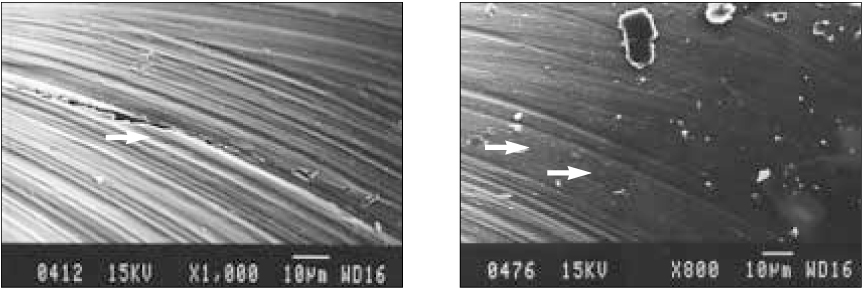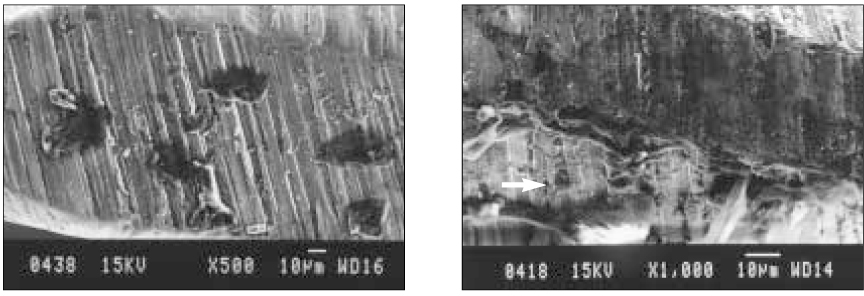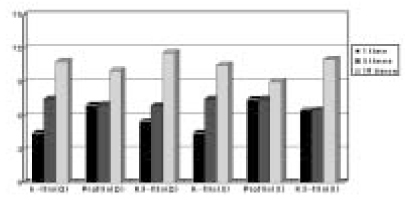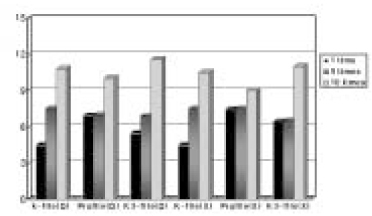Articles
- Page Path
- HOME > Restor Dent Endod > Volume 30(2); 2005 > Article
- Original Article The effect of NaOCl treatment and sterilization procedures on the corrosion of endodontic files
- Won-Kyung Yang1, Yoon-Sik Ra1, Young-Kyoo Lee2, Ho-Hyun Son3, Mi-Ri Kim1
-
2005;30(2):-127.
DOI: https://doi.org/10.5395/JKACD.2005.30.2.121
Published online: March 31, 2005
1Department of Conservative Dentistry, Department of Dentistry, Asan Medical Center, Korea.
2Department of Periodontics, Department of Dentistry, Asan Medical Center, Korea.
3Department of Conservative Dentistry, College of Dentistry, Seoul National University, Korea.
- Corresponding author: Mi-Ri Kim. Department of Conservative Dentistry, Department of Dentistry, Asan Medical Center, 388-1, Poongnap-dong, Songpa-gu, Seoul, Korea, 138-736. Tel: 82-2-3010-3824, Fax: 82-2-3010-6967, kmr333@unitel.co.kr
• Received: August 30, 2004 • Revised: October 28, 2004 • Accepted: November 9, 2004
Copyright © 2005 Korean Academy of Conservative Dentistry
- 157 Views
- 1 Download
- 1 Crossref
Abstract
-
A variety files made of stainless steel (S-S) or nickel-titanium (Ni-Ti) are used during endodontic treatment. The purpose of this study was to evaluate the corrosion susceptibility of S-S and Ni-Ti endodontic files. Three brands of files were used for this study: K-flex® S-S files (Maillefer, USA), Profile® Ni-Ti files (Maillefer, USA), K-3® Ni-Ti files (SybronEndo, USA). 120 files of each brands (21mm, ISO size #20) were divided into 12 groups according to 1) sterilization methods using Autoclave or Ethylene Oxide (E-O) gas, 2) Irrigation solutions using 5.25 % NaOCl or Saline, 3) the number of sterilization (1, 5, 10 times). After above procedures, each of the files was inspected by three examiners with a light microscope and camera at X25. Each file was judged and ranked according to the following criteria: 0; no corrosion, 1; mild corrosion, 2; moderate corrosion, and 3; severe corrosion. The files of high score were examined under the Scanning Electron Microscope.Data were statistically analyzed with the Kruskal-Wallis test (p < 0.05). Most of the ten time-autoclaved files had showed mild to moderate corrosion. But, one or five time-autoclaved files did not show corrosive surface. NaOCl treatment and E-O gas sterilization did not influence on corrosion. There was a significant difference in corrosion susceptibility between sterilization methods and the number of autoclaving. However, there was no significant difference between brands and file materials.
Figure 2

SEM photographs of K-flex® file treated with sodium hypochlorite and autoclaved ten-times (left arrow; fissure line, right arrows; pitting).

Figure 3

Low magnification (left) and high magnification (right) of Profile® treated with sodium hypochlorite and autoclaved ten-times (arrow; pitting)

Figure 4

Low magnification (left) and high magnification (right) of K-3® file treated with sodium hypochlorite and autoclaved ten-times (arrows; pitting).

Figure 5

Sum of corrosion scores of autoclaved files (O; NaOCl, X; Saline).
Ten times-autoclaved files had significantly different from one or five times-autocaved files (p < 0.05). There was no significant difference between brands and file materials.

- 1. Bahcall JK, Barss JT. Understanding and evaluating the endodontic file. Gen Dent. 2000;48: 690-692.PubMed
- 2. Walia HM, Brantley WA, Gerstein H. An initial investigation of the bending and torsional properties of nitinol root canal files. J Endod. 1988;14: 346-351.ArticlePubMed
- 3. Assad M, Chernyshov AV, Jarzem P, Leroux MA, Coillard C, Charette S, Rivard CH. Porous titanium-nickel for Intervertebral fusion in a sheep model: part 2. Surface analysis and nickel release assessment. J Biomed Mater Res B Appl Biomater. 2003;64: 121-129.ArticlePubMed
- 4. Mize SB, Pruett JP, Clement DJ, Carnes DL. Effect to sterilization on cyclic fatigue of rotary nickel-titanium endodontic instruments. J Endod. 1998;24: 843-847.PubMed
- 5. Filho IB, Esberard RM, Leonardo RT, Del Rio CE. Microsopic evaluation of three endodontic files pre- and postinstrumentation. J Endod. 1998;24: 461-464.PubMed
- 6. Stokes OW, Di Fiore PM, Barss JT, Koerber A, Gilbert JL, Lautenschlager EP. Corrosion in stainless-steel and nickel titanium files. J Endod. 1999;25: 17-20.ArticlePubMed
- 7. Neal RG, Craig RG, Powers JM. Effects of sterilization and irrigants on the cutting ability of stainless steel files. J Endod. 1983;9: 93-96.PubMed
- 8. Haikel Y, Serfaty R, Speisser WJM, Alleman C. Cutting efficiency of nickel-titanium endodontic instruments and the effect of sodium hypochlorite treatment. J Endod. 1998;24: 736-739.ArticlePubMed
- 9. Busslinger A, Sener B, Barbakow F. Effects of sodium hypochlorite on nickel-titanium Lightspeed instruments. Int Endod J. 1998;31: 290-294.PubMed
- 10. Haikel Y, Serfaty R, Speisser WJM, Alleman C. Mechanical properties of nickel-titanium endodontic instruments and the effect of sodium hypochlorite treatment. J Endod. 1998;24: 731-735.ArticlePubMed
- 11. Sarkar NK, Redmond W, Schwaninger B, Goldberg AJ. The chloride corrosion behaviour of four orthodontic wires. J Oral Rehabil. 1983;10: 121-128.ArticlePubMed
- 12. Hurtt CA, Rossman LE. The sterilization of endodontic hand files. J Endod. 1996;22: 321-322.ArticlePubMed
- 13. Charles , et al. Sterilization or disinfection of dental instruments. Accepted dental therapeutics 40th. 1984;Chicago, IL: American Dental Association; 134-150.
- 14. Willet NP, White RR, Rosen S. Disinfection and sterilization. Essential Dental Mocrobiology. 1991;Appletin & Lange, East Norwalk, CO; 58-61.
REFERENCES
Tables & Figures
Figure 2

SEM photographs of K-flex® file treated with sodium hypochlorite and autoclaved ten-times (left arrow; fissure line, right arrows; pitting).

Figure 3

Low magnification (left) and high magnification (right) of Profile® treated with sodium hypochlorite and autoclaved ten-times (arrow; pitting)

Figure 4

Low magnification (left) and high magnification (right) of K-3® file treated with sodium hypochlorite and autoclaved ten-times (arrows; pitting).

Figure 5

Sum of corrosion scores of autoclaved files (O; NaOCl, X; Saline).
Ten times-autoclaved files had significantly different from one or five times-autocaved files (p < 0.05). There was no significant difference between brands and file materials.

REFERENCES
- 1. Bahcall JK, Barss JT. Understanding and evaluating the endodontic file. Gen Dent. 2000;48: 690-692.PubMed
- 2. Walia HM, Brantley WA, Gerstein H. An initial investigation of the bending and torsional properties of nitinol root canal files. J Endod. 1988;14: 346-351.ArticlePubMed
- 3. Assad M, Chernyshov AV, Jarzem P, Leroux MA, Coillard C, Charette S, Rivard CH. Porous titanium-nickel for Intervertebral fusion in a sheep model: part 2. Surface analysis and nickel release assessment. J Biomed Mater Res B Appl Biomater. 2003;64: 121-129.ArticlePubMed
- 4. Mize SB, Pruett JP, Clement DJ, Carnes DL. Effect to sterilization on cyclic fatigue of rotary nickel-titanium endodontic instruments. J Endod. 1998;24: 843-847.PubMed
- 5. Filho IB, Esberard RM, Leonardo RT, Del Rio CE. Microsopic evaluation of three endodontic files pre- and postinstrumentation. J Endod. 1998;24: 461-464.PubMed
- 6. Stokes OW, Di Fiore PM, Barss JT, Koerber A, Gilbert JL, Lautenschlager EP. Corrosion in stainless-steel and nickel titanium files. J Endod. 1999;25: 17-20.ArticlePubMed
- 7. Neal RG, Craig RG, Powers JM. Effects of sterilization and irrigants on the cutting ability of stainless steel files. J Endod. 1983;9: 93-96.PubMed
- 8. Haikel Y, Serfaty R, Speisser WJM, Alleman C. Cutting efficiency of nickel-titanium endodontic instruments and the effect of sodium hypochlorite treatment. J Endod. 1998;24: 736-739.ArticlePubMed
- 9. Busslinger A, Sener B, Barbakow F. Effects of sodium hypochlorite on nickel-titanium Lightspeed instruments. Int Endod J. 1998;31: 290-294.PubMed
- 10. Haikel Y, Serfaty R, Speisser WJM, Alleman C. Mechanical properties of nickel-titanium endodontic instruments and the effect of sodium hypochlorite treatment. J Endod. 1998;24: 731-735.ArticlePubMed
- 11. Sarkar NK, Redmond W, Schwaninger B, Goldberg AJ. The chloride corrosion behaviour of four orthodontic wires. J Oral Rehabil. 1983;10: 121-128.ArticlePubMed
- 12. Hurtt CA, Rossman LE. The sterilization of endodontic hand files. J Endod. 1996;22: 321-322.ArticlePubMed
- 13. Charles , et al. Sterilization or disinfection of dental instruments. Accepted dental therapeutics 40th. 1984;Chicago, IL: American Dental Association; 134-150.
- 14. Willet NP, White RR, Rosen S. Disinfection and sterilization. Essential Dental Mocrobiology. 1991;Appletin & Lange, East Norwalk, CO; 58-61.
Citations
Citations to this article as recorded by 

- Comparison of Various Cold Sterilization Techniques on Routinely used Carbide Burs and Diamond Points
Suganthi Ranganathan, Supriya Manvi, Srivatsa Gopalakrishna, Chaitra Koppal Renukanath
International Journal of Prosthodontics and Restorative Dentistry.2017; 7(3): 97. CrossRef
The effect of NaOCl treatment and sterilization procedures on the corrosion of endodontic files






Figure 1
Low magnification of untreated K-flex® file, Profile®, and K-3® file (SEM photo).
Figure 2
SEM photographs of K-flex® file treated with sodium hypochlorite and autoclaved ten-times (left arrow; fissure line, right arrows; pitting).
Figure 3
Low magnification (left) and high magnification (right) of Profile® treated with sodium hypochlorite and autoclaved ten-times (arrow; pitting)
Figure 4
Low magnification (left) and high magnification (right) of K-3® file treated with sodium hypochlorite and autoclaved ten-times (arrows; pitting).
Figure 5
Sum of corrosion scores of autoclaved files (O; NaOCl, X; Saline).
Ten times-autoclaved files had significantly different from one or five times-autocaved files (p < 0.05). There was no significant difference between brands and file materials.
Figure 6
Sum of corrosion scores of E-O gas sterilized files (O; NaOCl, X; Saline).
EO-gas sterilized files did not showed significantly different from each other (p < 0.05). There was no significant difference between brands and file materials.
Figure 1
Figure 2
Figure 3
Figure 4
Figure 5
Figure 6
The effect of NaOCl treatment and sterilization procedures on the corrosion of endodontic files
Classification of the experimental groups. The files in each group were immersed in 5.25% sodium hypochlorite or normal saline for 10 minutes before sterilization (36 groups, n = 10 / group).
Table 1
Classification of the experimental groups. The files in each group were immersed in 5.25% sodium hypochlorite or normal saline for 10 minutes before sterilization (36 groups, n = 10 / group).

 KACD
KACD



 ePub Link
ePub Link Cite
Cite

